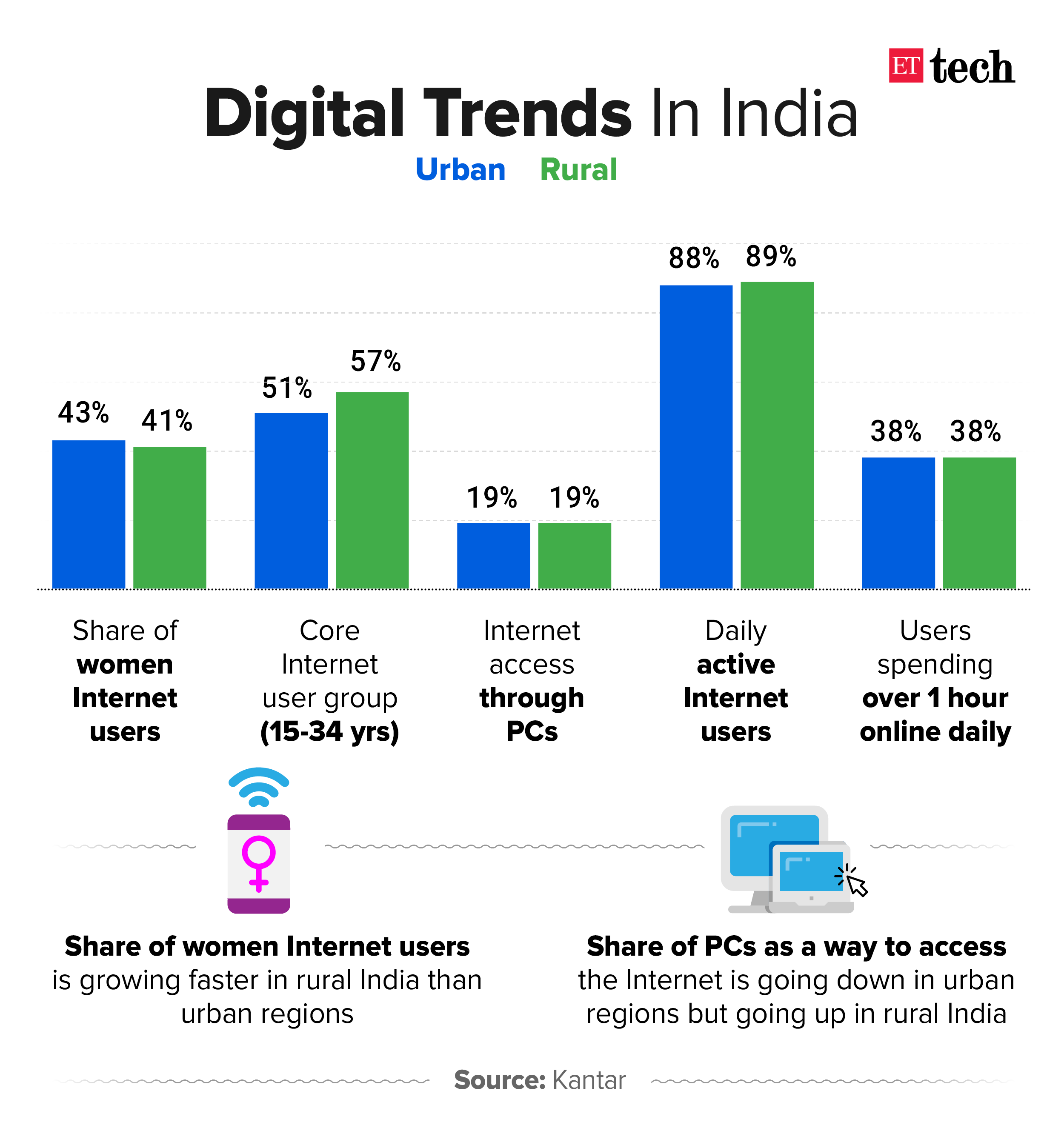Indian Science and Technology Developments : Updates and Discussions
- Thread starter Gautam
- Start date
You are using an out of date browser. It may not display this or other websites correctly.
You should upgrade or use an alternative browser.
You should upgrade or use an alternative browser.

WMO applauds India Meteorological Department for its prediction of cyclone Amphan
Terming the handling of the cyclone situation as an "excellent lesson", the WMO said the IMD was also to be commended for aiding India's neighbouring nations with accurate forecasts and preventing further loss of life and property.
Bharat is keeping step with India on Internet usage and patterns
With 265 million internet users, rural India is not only catching up with cities in terms of the sheer number of netizens, it is also mirroring the time spent, frequency, share of female users and mode of access with its urban cousin.
And, while internet usage might look similar on the surface, the activities which urban and rural users engage in online are different, according to data and insights by leading research firm Kantar, which were exclusively with ET.
Moreover, while urban India is close to reaching saturation levels with around 60% of the population having access to the internet, the headroom for growth in rural areas remains massive, Kantar said.
This could skew the way online companies and developers view India as a market.
Women now make up 41% of internet users in rural India, compared to 43% in urban regions. The number of daily active users in rural India is 89%, versus 88% for cities and towns, with close to 40% of users in both regions spending over one hour accessing the internet daily.

Internet access through personal computers stands at 19% for both.
The only slight difference in demographic shows up while analysing the share of users between the ages of 15 and 34, which Kantar calls the ‘core internet user group’.
This makes up 57% in rural regions and 51% in urban regions, signalling that various age groups in the urban populace are using the internet more.
“There is not much difference in the demographic or the overall usage and duration as well. But the moment we look at the usages, there's a significant difference. So, basically what this means is that, there are fewer activities that rural users are doing, but they’re doing it for a longer period of time,” said Biswapriya Bhattacharjee, executive vice president of the insights division at Kantar.
According to the research firm, rural users, on average, perform about 32% fewer activities than their urban counterparts on the internet.
However, when it comes to activities such as watching online videos and online search, rural users cross the average usage index, meaning they are doing more of this than other activities such as using social media.
While urban users consume more video content online, apps such as MX Player* and Jio TV see almost equal reach in urban and rural India.

The biggest surprise, however, is social media, where the overall lower adoption of Facebook and WhatsApp in rural India keeps the usage index at just 60, but TikTok scores 166.
Typically, scores higher than 100 mean the reach in rural areas is higher than in urban regions, and vice versa.
The usage index for Facebook in rural India is just 47, while for WhatsApp, it is even lower at 37. The least penetrated category in rural areas is online shopping, which gets a usage index of just 29.
“Rural is all about entertainment and social media,” added Bhattacharjee. “Shopping is much more of a higher order function. It’s not that rural users are not shopping online, it’s just that the penetration is much lower than for urban users.”

 tech.economictimes.indiatimes.com
tech.economictimes.indiatimes.com
With 265 million internet users, rural India is not only catching up with cities in terms of the sheer number of netizens, it is also mirroring the time spent, frequency, share of female users and mode of access with its urban cousin.
And, while internet usage might look similar on the surface, the activities which urban and rural users engage in online are different, according to data and insights by leading research firm Kantar, which were exclusively with ET.
Moreover, while urban India is close to reaching saturation levels with around 60% of the population having access to the internet, the headroom for growth in rural areas remains massive, Kantar said.
This could skew the way online companies and developers view India as a market.
Women now make up 41% of internet users in rural India, compared to 43% in urban regions. The number of daily active users in rural India is 89%, versus 88% for cities and towns, with close to 40% of users in both regions spending over one hour accessing the internet daily.
Internet access through personal computers stands at 19% for both.
The only slight difference in demographic shows up while analysing the share of users between the ages of 15 and 34, which Kantar calls the ‘core internet user group’.
This makes up 57% in rural regions and 51% in urban regions, signalling that various age groups in the urban populace are using the internet more.
“There is not much difference in the demographic or the overall usage and duration as well. But the moment we look at the usages, there's a significant difference. So, basically what this means is that, there are fewer activities that rural users are doing, but they’re doing it for a longer period of time,” said Biswapriya Bhattacharjee, executive vice president of the insights division at Kantar.
According to the research firm, rural users, on average, perform about 32% fewer activities than their urban counterparts on the internet.
However, when it comes to activities such as watching online videos and online search, rural users cross the average usage index, meaning they are doing more of this than other activities such as using social media.
While urban users consume more video content online, apps such as MX Player* and Jio TV see almost equal reach in urban and rural India.
The biggest surprise, however, is social media, where the overall lower adoption of Facebook and WhatsApp in rural India keeps the usage index at just 60, but TikTok scores 166.
Typically, scores higher than 100 mean the reach in rural areas is higher than in urban regions, and vice versa.
The usage index for Facebook in rural India is just 47, while for WhatsApp, it is even lower at 37. The least penetrated category in rural areas is online shopping, which gets a usage index of just 29.
“Rural is all about entertainment and social media,” added Bhattacharjee. “Shopping is much more of a higher order function. It’s not that rural users are not shopping online, it’s just that the penetration is much lower than for urban users.”

Bharat is keeping step with India on Internet usage and patterns
While urban India is close to reaching saturation levels with around 60% of the population having access to the internet, the headroom for growth in rural areas remains massive
Okay but there is already one, known as inconel
and inconel-188 is used for rocket engines too.
and none work in India lol. desh bhakt bharitis....take education and everything here subsidised by GOI and poor indians and then go to America to clean a** of there white papa.
You are just an old rag commie ideologist who cant stop criticizing but don't want to change it either.and none work in India lol. desh bhakt bharitis....take education and everything here subsidised by GOI and poor indians and then go to America to clean a** of there white papa.
Yes, They are going outside because there is no high tech industry or innovation hubs that can employ them. Because of license raj, antibusiness, and the supremely incompetent PSUs which still hold a monopoly in many fields. Oh did i mention reservation?
If I ask you why not let ease or reform all these including the restriction-free private university education. Then you are gonna blabber about crony capitalism and profit-making.
Keep producing these gems with your lazy *censored* from your parents closet who was probably a PSU employee.
everything is here... they just want to be white so bad it's not even funny Lola! . Pvt sector universities in India are all profit making with substandard education. not a single toilet paper worth of research come from them.You are just an old rag commie ideologist who cant stop criticizing but don't want to change it either.
Yes, They are going outside because there is no high tech industry or innovation hubs that can employ them. Because of license raj, antibusiness, and the supremely incompetent PSUs which still hold a monopoly in many fields. Oh did i mention reservation?
If I ask you why not let ease or reform all these including the restriction-free private university education. Then you are gonna blabber about crony capitalism and profit-making.
Keep producing these gems with your lazy *censored* from your parents closet who was probably a PSU employee.

Is semiconductor manufacturing in India an unworkable project?
Semiconductor manufacturing comprises the front-end fab manufacturing and the back-end assembly, including packaging and testing. There are only a handful of companies globally that do front-end manufacturing at scale.
Your views.
@Bali78
This article is spot on. Apple is world’s second largest chip making company after Intel, but all it’s chips are made in TSMC.
Is semiconductor manufacturing in India an unworkable project?
Semiconductor manufacturing comprises the front-end fab manufacturing and the back-end assembly, including packaging and testing. There are only a handful of companies globally that do front-end manufacturing at scale.www.deccanherald.com
Your views.
@Bali78
India should rather focus on system design.


